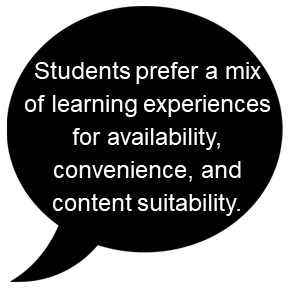Author: Charlotte Jones-Roberts, University of Central Florida
Editor: Dr. Denise Lowe, University of Central Florida
Dear ADDIE,
As an online faculty member in higher education, I find myself grappling with the multitude of course modalities available, from fully online to blended to hyflex. Each modality seems to come with its own set of challenges and advantages. How can I navigate these different modalities effectively to ensure the best learning experience for my students while also managing my workload as an instructor? Any guidance would be greatly appreciated.
Sincerely,
Mixed-up Modalities
Dear Mixed-up,
Navigating the ever-changing world of online learning can feel like trying to find your way through a maze, especially with the plethora of course options available. But fear not! You’re not alone in this journey.
Thanks to the unexpected shift brought on by COVID-19, online learning has become more prevalent than ever before. This has opened up a world of possibilities, but it’s also introduced its fair share of challenges. One thing that’s become clear is the need for flexibility to meet the diverse needs of today’s students – and there are many modalities to choose from.

According to a 2023 report by Garrett et. al., face-to-face enrollment for traditional undergraduates is either stagnant or declining, with 57% of chief online officers (COOs) reporting stagnation and 24% reporting declines. In contrast, online and hybrid program enrollments are on the rise, with 36% and 20% of COOs reporting growth, respectively. To meet the growing demand for online and hybrid programs, institutions are swiftly realigning their strategic priorities, with approximately 50% of COOs confirming support for greater emphasis on online and multi-modal learning, though resource constraints remain a challenge, and 36% are currently reconsidering their strategic priorities (Garrett et. al., 2023).
Institutions are now offering a smorgasbord of options, ranging from fully online courses to traditional face-to-face instruction, and everything in between. Students increasingly prefer a mix of classroom, online, and hybrid learning experiences due to factors like availability, convenience, and suitability for the content (Garrett et. al., 2023).
This trend results in most students, both at the undergraduate and graduate levels, encountering various delivery modes throughout their academic journey, including the innovative Hyflex model championed by Beatty (2019). This approach gives students the freedom to choose whether they want to attend class in person or participate remotely, giving them the flexibility they crave in their busy lives. The beauty of the Hyflex model lies in its ability to seamlessly blend the best of both worlds. By incorporating a mix of synchronous and asynchronous elements, instructors can create a dynamic learning environment that caters to the needs of all students, no matter where they are.
For instance, in a hyflex biology course, students could choose to participate in lab experiments physically on campus or virtually via live-streamed sessions. Assignments, discussions, and assessments would be accessible and identical for both in-person and remote learners, ensuring equitable participation and learning outcomes. It’s all about giving you options and making sure everyone’s on the same page, whether you’re in the classroom or chilling at home in your PJs.
The key is keeping clear expectations and communication with students. This includes which modality has been selected, what that modality means at your institution, expectations for participation, and guidelines for accessing course materials in both face-to-face and online environments to ensure that students understand what is required of them regardless of the mode of instruction they choose.
So as you embark on this adventure, remember to keep an open mind and embrace the opportunities that come your way. With a little bit of creativity and a whole lot of flexibility, you’ll be sure to create engaging and inclusive learning experiences for your students.
Happy navigating!
ADDIE
References
Beatty, B. J. (2019). Hybrid-Flexible Course Design (1st ed.). EdTech Books. https://dx.doi.org/10.59668/33
Garrett, R., Simunich, B., Legon, R., & Fredericksen, E. E. (2023). CHLOE 8: Student Demand Moves Higher Ed Toward a Multi-Modal Future, The Changing Landscape of Online Education. Quality Matters and Encoura Eduventures Research, 15. Retrieved from: https://qualitymatters.org/qa-resources/resource-center/articles-resources/CHLOE-8-report-2023
